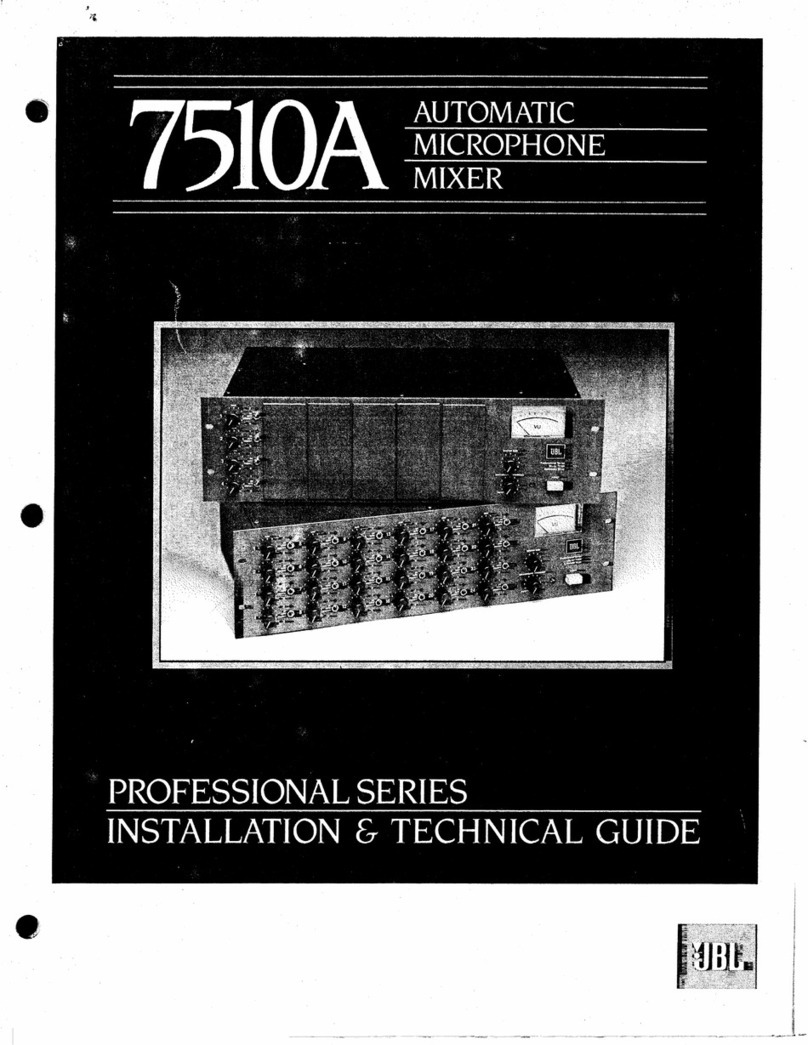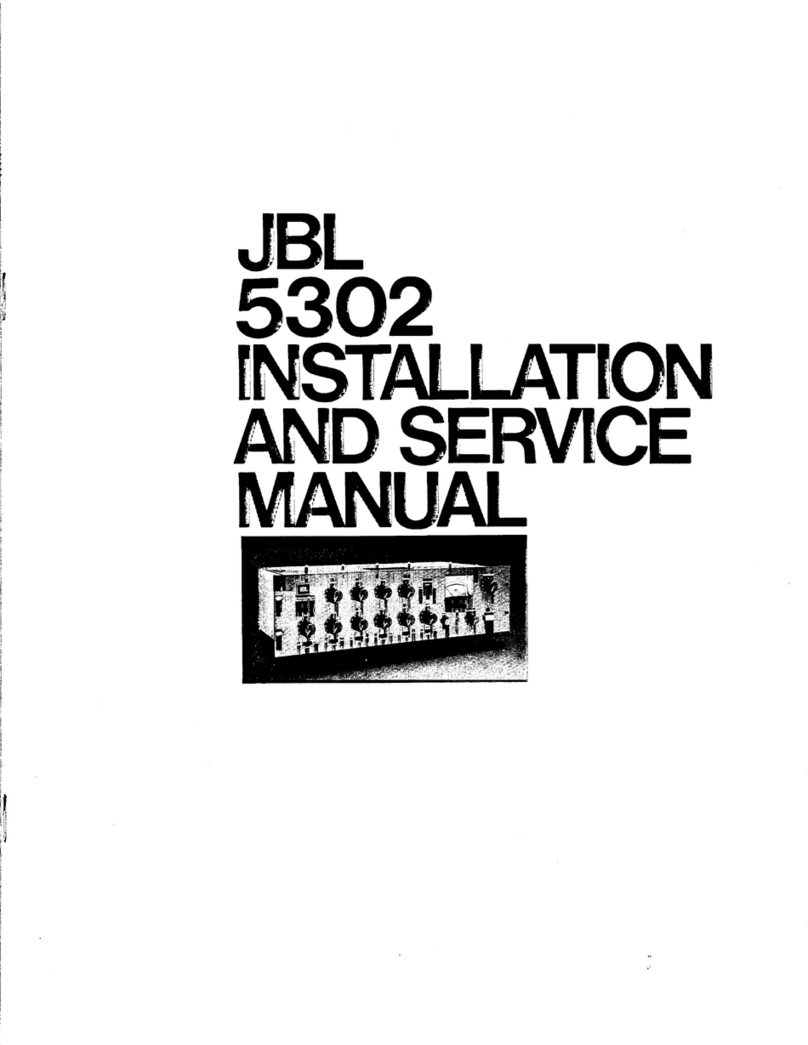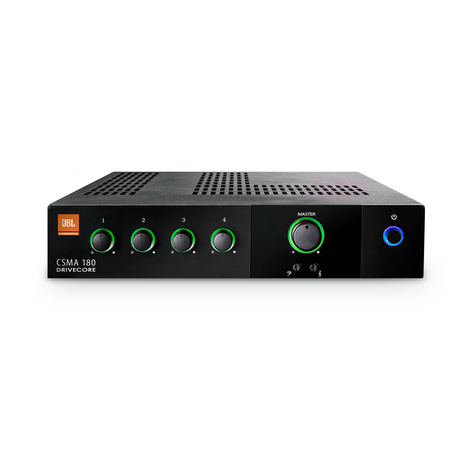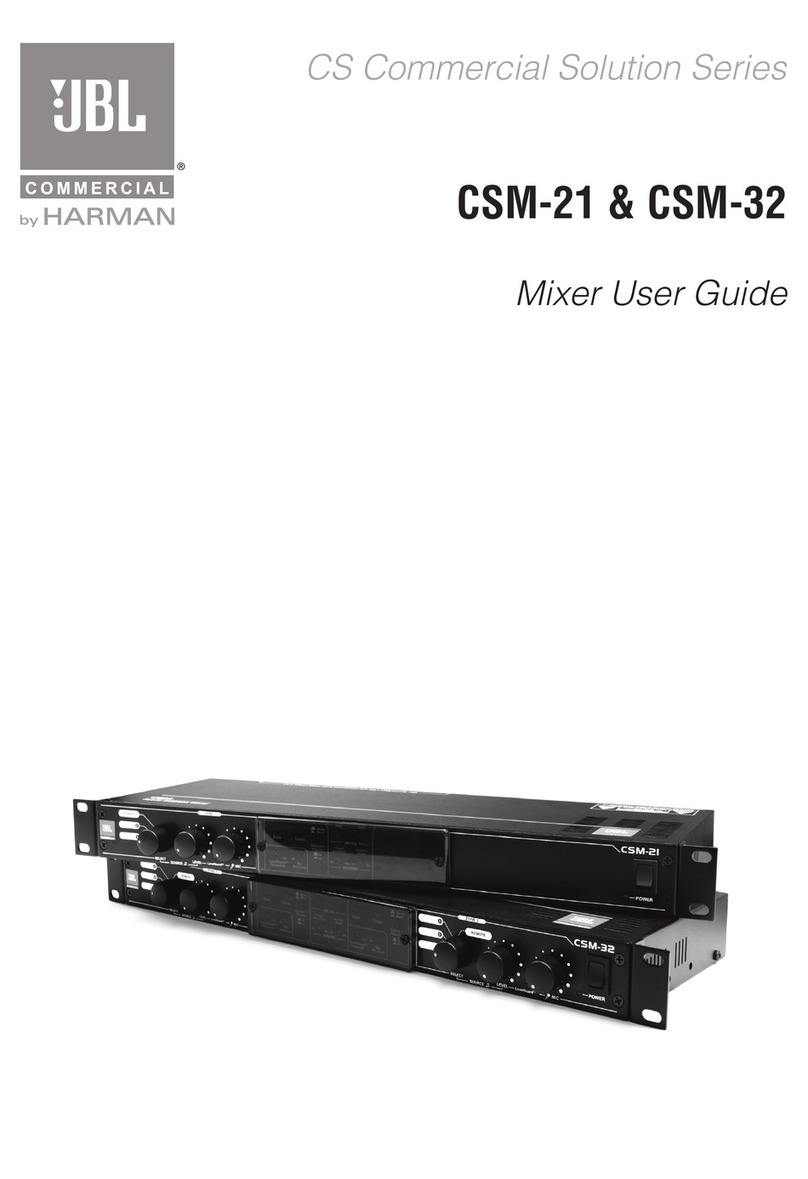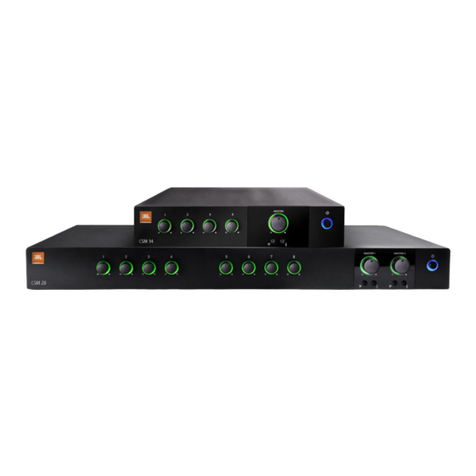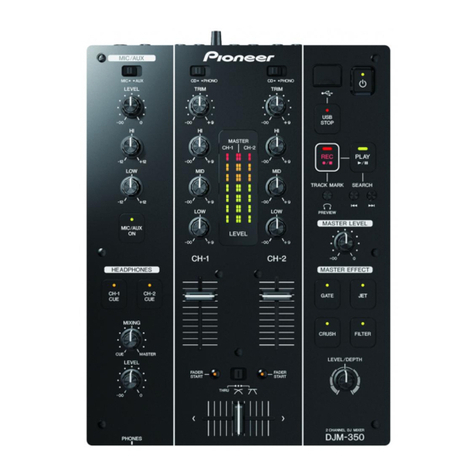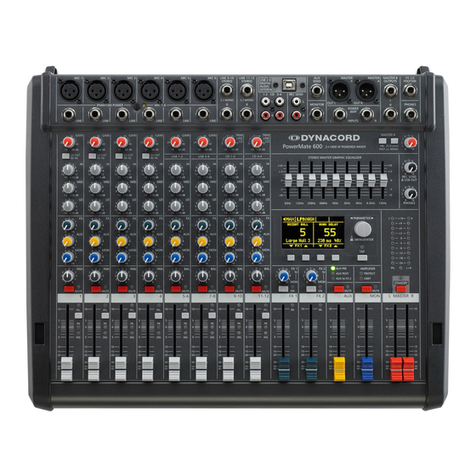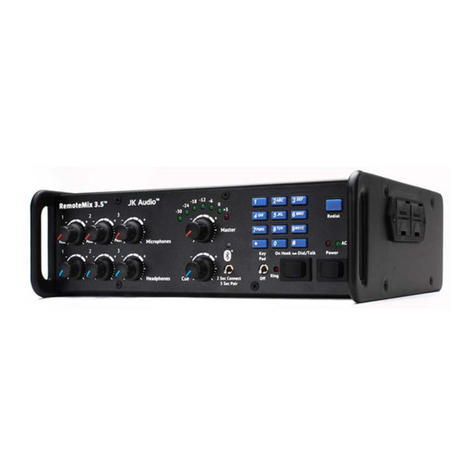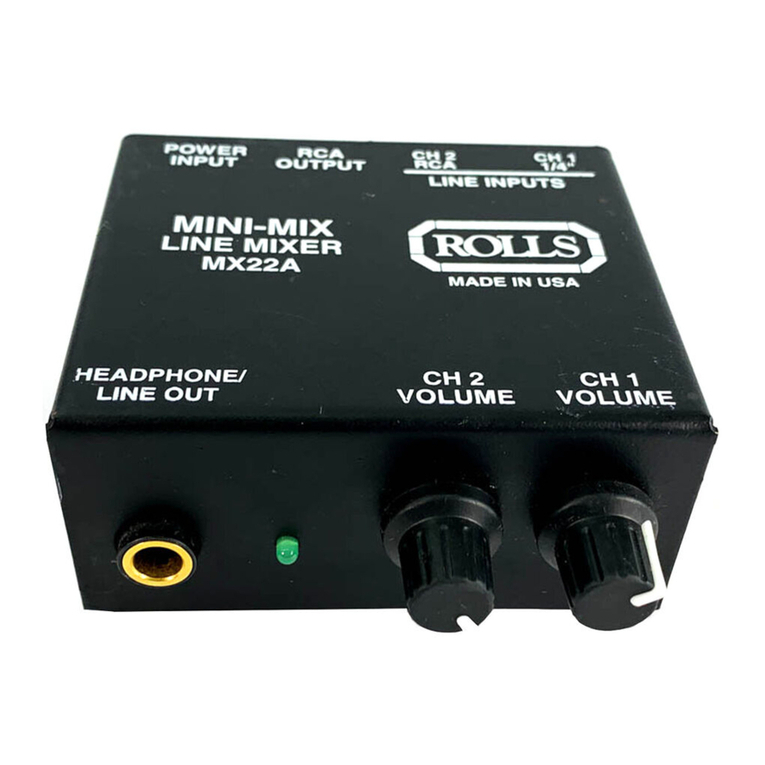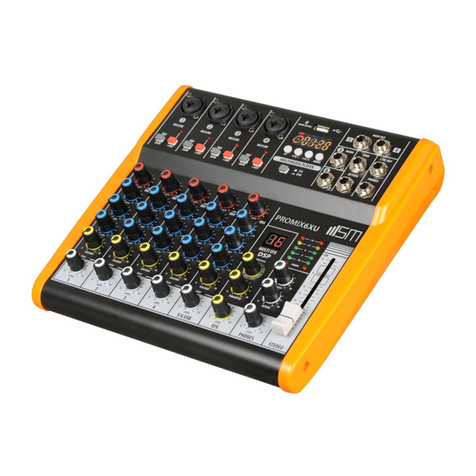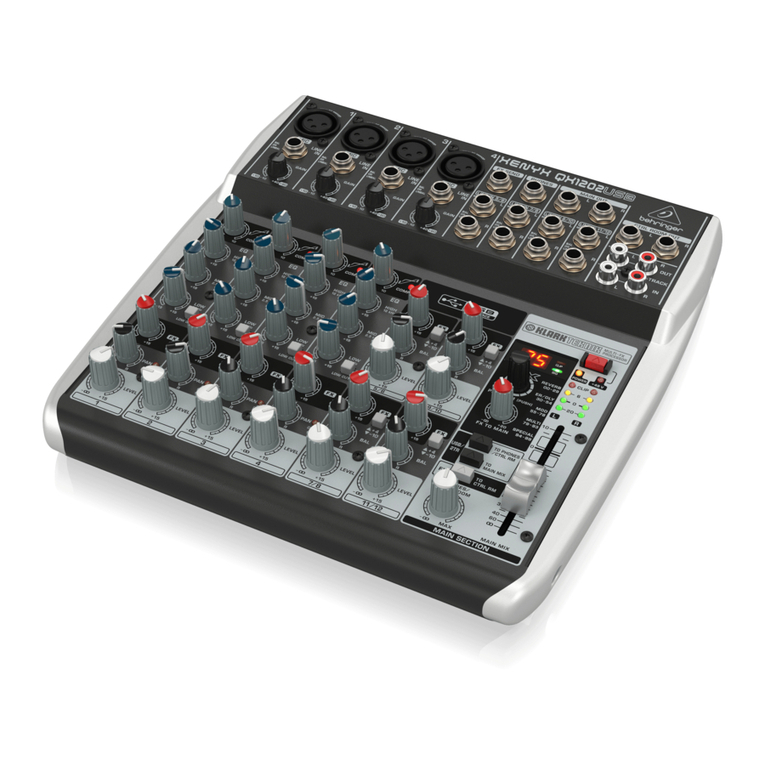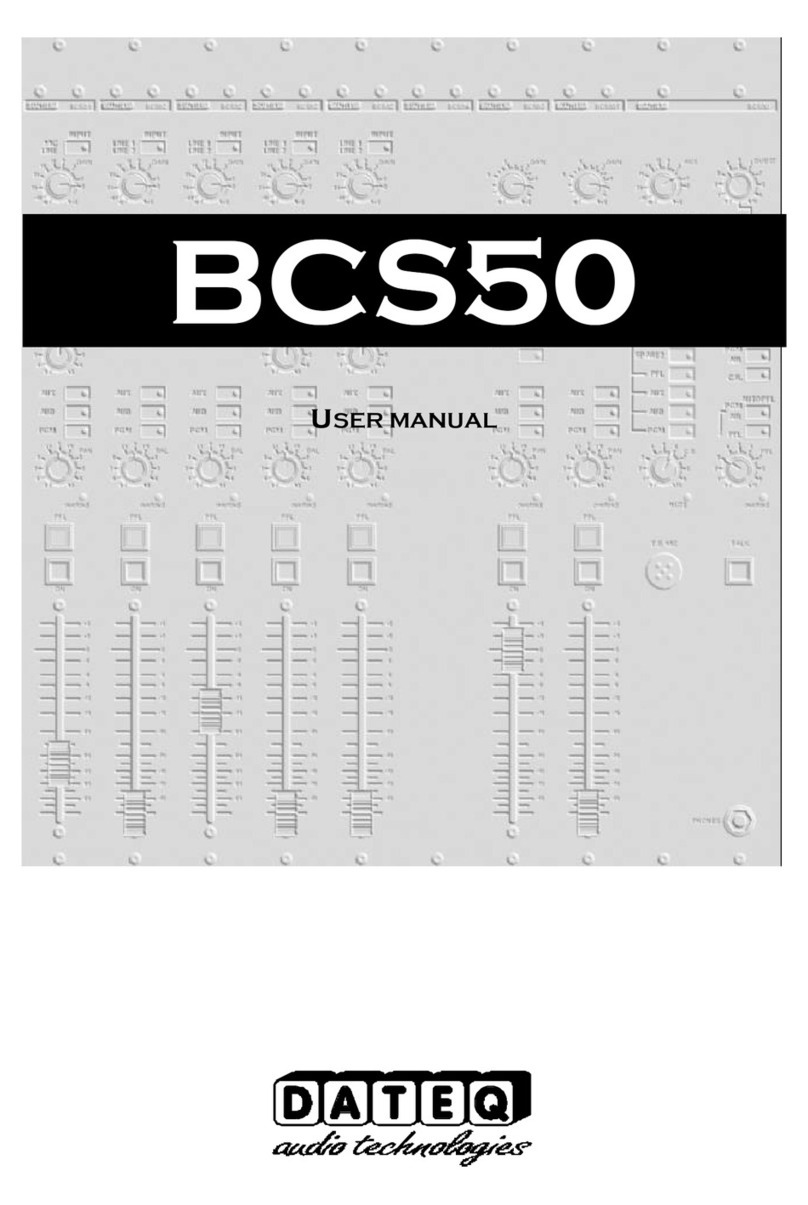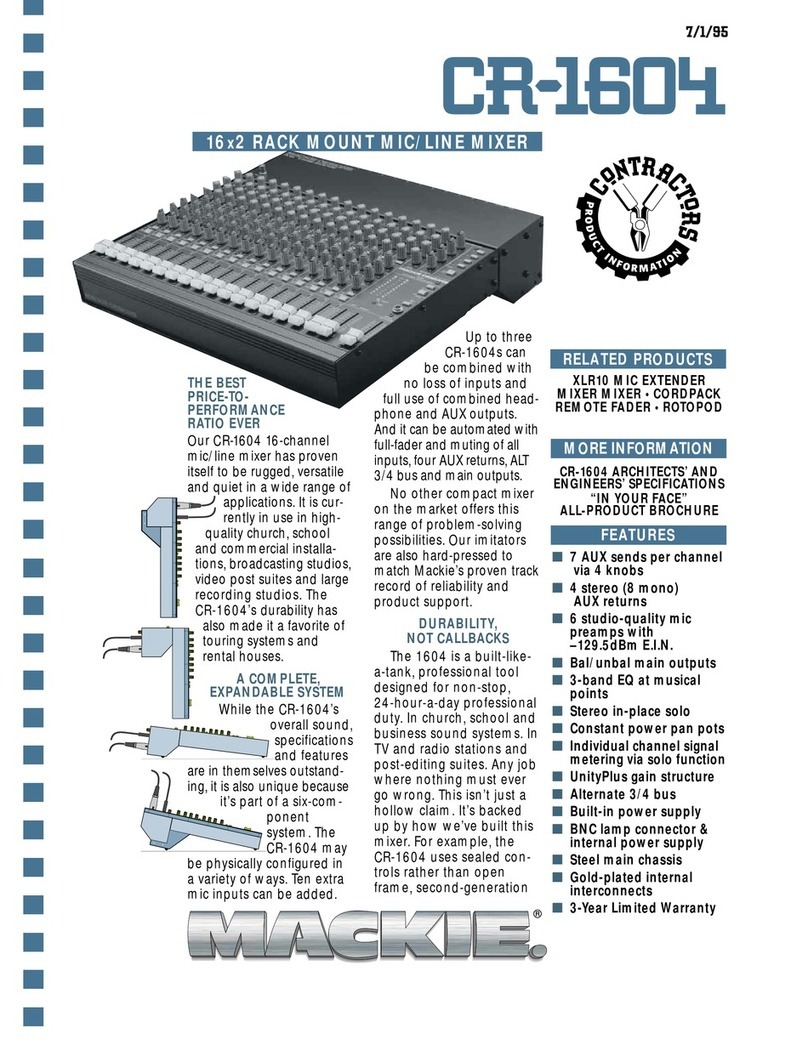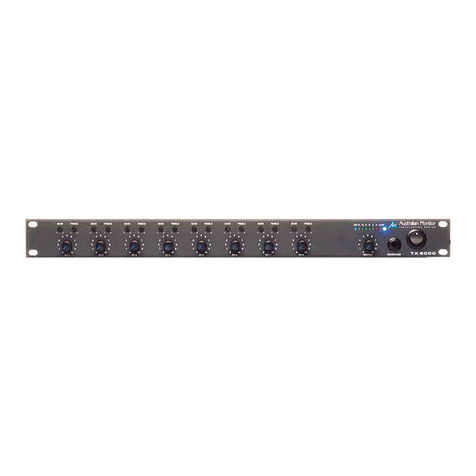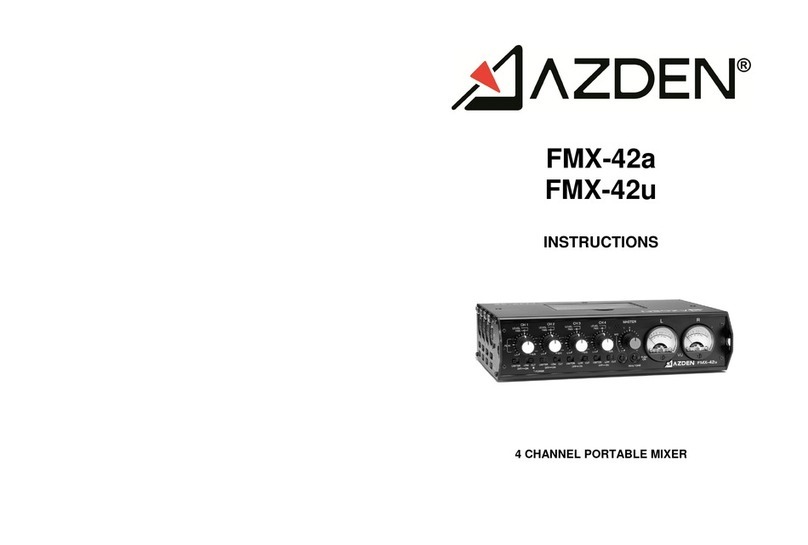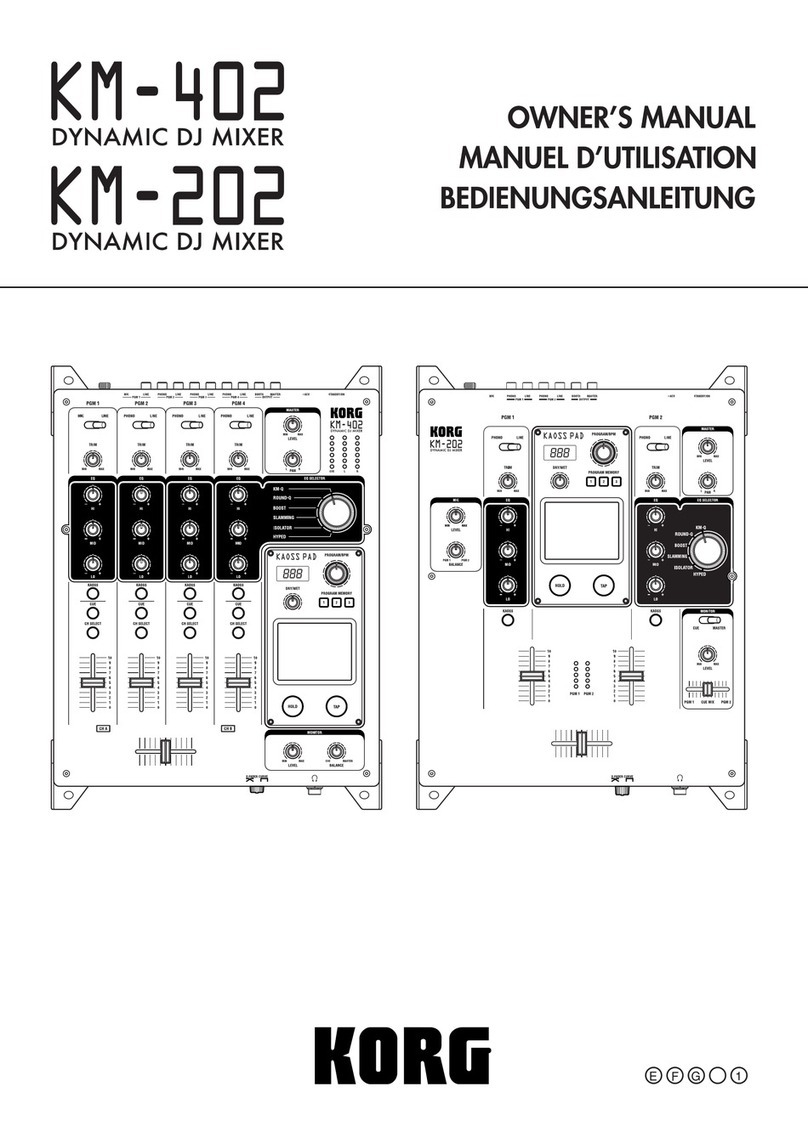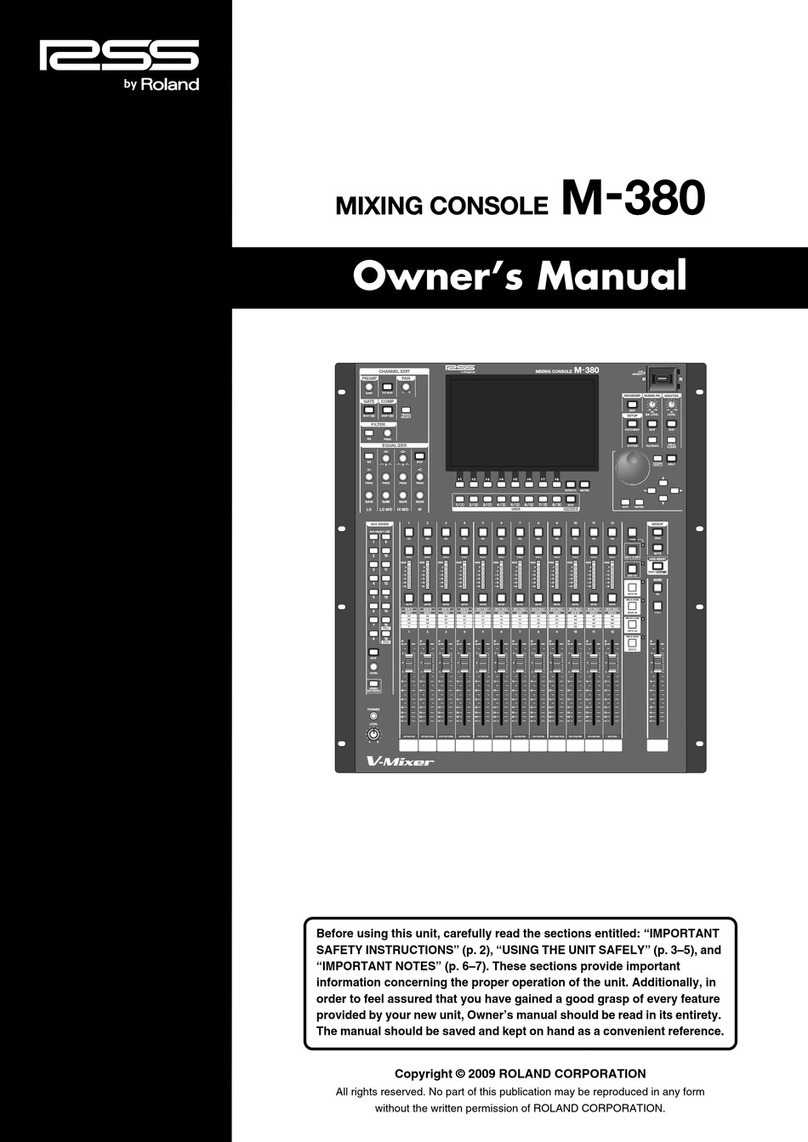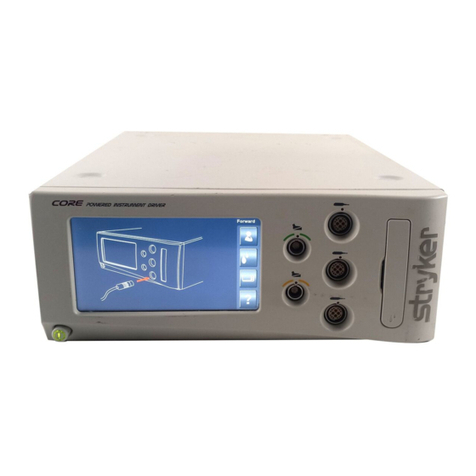JBL 7510B User manual

BEFORE PROCEEDING WITH COMPLETE UNPACKING AND SETUP
PLEASE READ THE SECTION ON UNPACKING AND INSPECTION
OBL UREI
ELECTRONIC
PRODUCTS
model 751 OB
AUTOMATIC MICROPHONE MIXER
JBL Incorporated
8500 BALBOA BOULEVARD
P.O. BOX 2200
NORTHRIDGE, CA. 91329 USA
PHONE: (818 )893-8411
TELEX: 4720424
JBL PROPEeSldNAL
Ifetls^bMER
H.8370 3^POA.BOULEVAFD SA.
15- NORTHRIOGE, m, 0132,9. U.SJV;
^RQNE (818) 893-8411
FAXtsisj 891-9619
©Copyright 1988, JBL Incorporated

Manual 751 OB
J.JL...P.reface
Section One introdUCliOD
Thank you for purchasing this JBIVUREI product We have prepared this instruction manual to enable you to
achieve optimum utility and performance from your new Automatic Microphone Mixer. We encourage you to
read and to make use of the material contained in this manual. We welcome your suggestions and comments
on our products and on this manual.
This manual is dedicated to all the people who are interested in learning about the capabilities and limitations of
our products in order to best use them. Learn, Enjoy and Share.
1.2 Unpacking and Inspection
Your new JBL/UREI Automatic Microphone Mixer was carefully packed at the factory, and the container was
designed to protect the unit during shipment Nevertheless, we recommend careful examination of the
shipping carton and its contents for any sign of physical damage which may have occurred in transit
If damage is evident do not destroy any of the packing material or the carton, and immediately notify the
carrier of apossible claim for damage. Damage claims must be made by you.
The shipping carton should contain:
The JBL/UREI Model 7510B Automatic Microphone Mixer
This Instruction Manual
An envelope containing Rack Mounting Hardware
If you have purchased extra 7510-03 Input Expander Assemblies, they are separately packed.
1.3 About this_Mamjal
The diagrams and information on the following two pages provide an overview of the controls, indicators and
connectors of the Model 75 lOB Automatic Microphone Mixer. Additional detailed information follows in the
Installation, (derating Instructions, and Theory of Operation sections.
Note: In this manual, unless otherwise specified, 0dBu is equivalent to 0.775 volts and 0dBm is one
milliwatt in acircuit with aload impedance of 600 ohms.
Page 1

1.4 Front Panel
A. Input Gain Control
Manual 751 OB
Adjust to compensate for different volume level
from different talkers, microphones and
source-to-microphone distances.
BRelease
Screwdriver adjust trimpot. Adjusts the time
delay before an active channel is turned OFF.
Fastest release is full CCW. Turn the control
CW to avoid channel turn-off between words.
C. Threshold
Screwdriver adjust trimpoL Sets the level of
signal required to turn ON the input in Automatic
or Priority modes. The most sensitive position is
with the control set full CW. Turn the control
CCWto reduce die sensitivity (increase the
threshold level )of the channel. Note that the
threshold is also affected by the input gain
control which should be set first for mix balance.
D. Channel On LED
Turns on whenever the channel is active. An
excellent tool for checking for marginal settings
of threshold and release controls.
*‘*•"
©
22(’)8AUTO ^
^y^wiiomTv
010 9A
E. Mode Switch
Select ON to defeat the Auto Mix function. The
channel will always be live.
Select AUTO to choose the Auto Mix function.
Achannel will turn ON when its input exceeds
the threshold level.
Figure 1The Front Panel-Input Section
Select PRIORITY to choose Priority function. The channel will turn ON under the same conditions as in
AUTO mode, but will simultaneously turn OFF all inputs which are live and in the AUTO mode. No other
inputs which are in the AUTO mode may turn ON wMe aPRIORITY input is live. Do not select more than
one or two inputs to be in PRIORITY mode. PRIORITY mode allows one input to take control of the mixer.
Too many PMORITY channels defeats this purpose. PRIORITY mode does not affect channels which have
been placed in the ON mode.
Page 2

Manual 751 OB
F. Master Gain
This is the normal Master mix control. It controls output
level tom the Main OuQ)ut
G. Background Threshold Control
At full CCW click position the threshold for turning ON
an individual channel is fixed, and is set only by the
threshold circuit of that individual channel. In any other
position of the Background Threshold control, the
threshold varies according to the amount of signal sensed
from all of the microphones in the system. As the
“background” level rises, so does the threshold for
turning ON achannel. CW rotation of the control
increases the amount by which an individual channel
input level must exceed the “background” before it will
turn ON.
H. Output Meter
0VU is calibrated to +4 dBm at the Main Output.
I. Power LED
J. Voltage Test Point
For adjustment of background preset voltage and offset.
See Section 2.4.4.
K. RTI-Background Preset trimpot.
See Section 2.4.4.
L. RT2-Background Offset trimpot.
See Section 2.4.4.
M. Power Switch Figure 2The Front Panel -Output Section
Page 3

Manual 751 OB
Three pin XL style connector. Pin 1is ground,
pin 3is “+” and pin 2is side of the floating
output. The signal level from this connector is
controlled by Ae front panel Master Gain control.
A10 kohm input on a3-conductor phone jack
may be wired either of two ways. Shield is
ground. An input wired to the tip contact returns
signal to asumming amplifier under control of
the NOM circuit. Level, therefore, varies with
the number of active inputs. An input wired to
the ring contact brings signal to another summing
amplifier just prior to the Master Gain control.
The level does not vary with the number of active
inputs.
This is alow impedance output prior to the
Master Gain control. Minimum load impedance
is 2kohm.
This 15 pin connector is for interconnecting two
7510B mainframes. See Page 10
Turn the switch ON to supply +48 VDC
Phantom Power to all inputs.
You can choose the "115" position of the AC
switch, and connect the cord to a120 VAC, 60
Hz, grounded power source, or you may choose
the "230" position of the AC switch, and connect
the cord to a240 VAC, 50/60 Hz, grounded
power source.
Page 4

Manual 751 OB
G. Input CoDPectof
This is a12 pin connector which serves all four inputs
on a7510-03 Input Assembly. Strip the wires, insert
into the holes as indicated by the rear panel silkscreen
and tighten the screws. The connector is atwo-piece
style which may be disconnected from the Input
Assembly for ease of wiring. See Input Connections on
Page 6.
H. Direct Output/Patch
£
0!^
A600 ohm nominal -t-4 dBu ouQ)ut is on the tip of the 3-
conductor phone jack, return to the summing buss of the
7510B is on the ring and ground is on the sleeve. The
output follows the circuit that turns the channel ON. See
Direct Outputs on Page 9.
I. Remote Control Connector
The gain of each of the input preamplifiers may be
changed by replacing the wire jumpers in the 15 pin
connector with resistors as discussed in Preamp Gain
Adjust on Page 7. Aswitch closure to ground upon
activation of any input is also available to drive external
logic circuitry. See Wiring of Logic Circuits on Page 7.
Figure 4The Rear Panel -Input Section
Section Two Installation
2.1 General
The following section contains installation and setup information. It is written in astep-by-step procedure
with minimal reference to other areas of the manual. Supplemental Information which may be of use to you in
the Installation and Setup phase follows immediately thereafter.
IMPORTANT—If you have never installed, set up or operated aModel 7510, 7510A or 7510B Automatic
Mixer, please read the short section on the Theory of Operation before continuing. Most installation and
operating problems arise because of an incomplete or incorrect understanding of how this product works.
TTiis understanding is very important to your ability to obtain the best performance from this Automatic Mic
Mixer.
WARNING:In many cases, installation of the 7510B Automatic Miaophone Mixer involves opening the unit
to gain access to internal circuit components. Since dangerous AC voltages may exist inside the unit, caution
must be exercised. These instructions are intended for use by qualified personnel only.
2.2 Installation
2.2.1. Check that the AC Line Voltage at your installation is correct for the Mixer. Look at the position of
the Voltage Change Switch on the rear panel and atag on the AC power cord which identify the AC mains
voltage for which your unit is wired. The 7510B can be powered from either 100 to 120 VAC or 200 to
Page 5

Manual 751 OB
240 VAC, 50 or 60 Hz mains. The Supply Voltage Select Switch on the rear panel converts the unit from one
operating range to the other.
As shipped, the unit is set for 100 to 120 VAC operation, and the line cord provided is suitable for use in the
U.S. or Canada. To convert the unit for operation with other mains voltages or outlet types, use the following
procedure:
1. Be sure the 7510B is not connected to any power source.
2. Slide the Supply Voltage Select Switch to the appropriate range.
3. Install asuitable plug or adaptor to mate the existing line cord with the powCT receptacle. The
751OB line cord uses a standard lEC 320 style AC Power Connector on the chassis. Amatching cordset with
aNEMA 5-15P plug is supplied. Cordsets to match other AC Mains outlets are available worldwide.
Note:Any line cord or adapter used for 200-240 Volt operation in the U.S. or Canada must be U.L.
Listed or C.S.A. Certified. For 240 VAC, 50/60 Hz operation in other countries, select aline cord or
adaptor based on governing local regulations.
Caution:This unit may be damaged if operated with the Supply Voltage Select Switch set incorrectly for
the line voltage applied. Also, verify that the mains are AC since, in some countries as well as certain
areas within the U.S., DC mains exist.
WARNING: ASIGNIFICANT FIRE AND SHOCK HAZARD MAY EXIST IF THE MIXER IS
CONNECTED TO AN AC POWER SOURCE OTHER THAN THAT FOR WHICH IT IS RATED
AND LABELLED.
2.2.2. If you have additional 75 10-03 Input Expansion Assemblies to install, to increase the number of
inputs above four, do it now. Follow the instructions enclosed with the 7510-03, or refer to Sections 2.4.3
and 2.4.4 of this manual.
2.2.3. Rack mount your Mixer with the enclosed rack mounting hardware. The Model 7510B Automatic
Microphone Mixer will operate satisfactorily over arange of ambient temperatures from 0® Cto +50® C(+32®
Fto +122® F), and up to 80% non-condensing relative humidity.
If the unit is installed in an equipment rack, console or other area along with high heat producing equipment
(such as power amplifiers), adequate ventilation should be provided to assure longest component life. Also,
while internal circuitry susceptible to hum pickup is sufficiently shielded from moderate electromagnetic fields,
avoid mounting the unit immediately adjacent to large power transformers, motors etc.
Caution: The 75 lOB AC power cord should not be connected to the power receptacle until all wiring is
completed. Also, any power amplifiers to which the Automatic Microphone Mixer may be connect^ should
be turned OFF until all wiring and setup procedures have been completed.
2.2.4. Connect audio input and output wiring. The following discussions include adescription of the
whys, wherefores and how-to's of wiring the connectors.
Input Connections
The Input Connector is a12 pin connector which serves all four inputs on a7510-03 Input Assembly. It is
quick and easy to wire, needing only wire strippers and asmall screwdriver, and it is areliable connector with
gold contact material to eliminate oxidation or corrosion of the contact surfaces in long term fixed installations.
&you have not seen this connector before, take amoment to examine it. You will notice that it is atwo-piece
connector which may be disconnected from the Input Assembly for ease of wiring. It is polarized, and Ae
Page 6

Manual 751 OB
latching mechanism is designed to make it easier to connect the two halves of the connector than to disconnect
them. The wires are held in adevice called acage-clamp which does not require that the wires be tinned,
although you may do that if you feel the need, ll^e cage-clamp will accommodate awire range of #14-#22
AWG. Strip tihe wires 1/4 inch, insert into the holes as indicated by the rear panel silkscreen, and tighten the
screws.
The Model 7510B Automatic Mixer provides +48 volt DC Phantom Power for condenser microphones.
Phantom Power gets its name from the fact tiiat the DC voltage is invisible to any BALANCED microphone
not specifically designed to use it. This includes most dynamic and ribbon microphones.. The Phantom
Power may be turned ON by the Phantom Power Switch on the Output Assembly. Turning this switch ON
supplies Phantom Power to all inputs except the auxiliary input located on the Output Assembly. Because of
the nature of the phantom circuitry it is not possible to use unbalanced connections with the Phantom Power
ON. DO NOT ATTEMPT TO USE AN UNBALANCED SOURCE WHENTHE PHANTOM POWER
SWITCH IS ON. SEVERE DAMAGE MAY OCCUR TO THE MICROPHONE (OR OTHER SOURCE
)
OR TO THE MIXER WHICH WILL NOT BE COVERED BY ANY MANUFACTURER'S WARRANTY.
Most microphones designed for Phantom Powering will operate from +48 volts, but if you have any doubts
about the use of aspecific microphone with the 7510B Mixer, consult the operating instructions for the
microphone or, if necessary, its manufacturer.
If none of your inputs require Phantom Power make sure that the Phantom Power Switch on the Output
Assembly is turned OFF.
If you wish to connect aLine level source to one of the inputs, but also need to supply Phantom Power to
condenser microphones, make sure that the source will not be damaged by application of +48 volt DC. If the
source is transformer balanced, that is fine. Otherwise you may need to install aDC blocking capacitor in
series with the input line. The capacitor should have its positive lead connected to the input terminal of the
751OB and its negative lead connected to the source. Acapacitor of 10p.F/50V minimum rating should be used
to avoid low frequency rolloff.
Pre-arop_Gain_Adiusl
The Input Preamp gain may be externally adjusted for optimum signal-to-noise and headroom. As shipped
from the factory the 15 pin connector on the rear panel of the Input Assembly includes four wire jumpers, one
for each of the four input channels. These jumpers, which set the gain of the input preamp at 49 dB, may be
removed and aresistor may be inserted in their place according to the values in Table 1on the next page. Use
only agood quality 1/8 or 1/4 watt carbon film or metal film resistor for best noise performance. Pin numbers
for the connectors are shown in Figure 5.
Wiring of Logic Circuits from Remote Control Connector
Figure 5shows the pin configuration for the Remote Control Connector on the rear panel of the Input
Assembly. In addition to the Preamp Gain adjustments described in the previous section, the 7510B also
provides acontact closure to ground when an input is activated. This contact closure, made through aCMOS
gate can switch ±5 volts with amaximum current of 10 milliamperes. Note that this is not avoltage source,
just acontact closure for an external source.
Figure 6shows several examples of circuits which could be used with this contact closure to activate relays,
drive Series 7400 TTL logic, LEDs, switch loudspeakers OFF to provide additional Acoustic Gain, switch
television cameras in ateleconferencing system etc.
Page 7

cn
VO
r-
00
ON
Manual 751 OB
labkl
Qaitt Resistor
unity open
4dB 10 kohm
7dB 4.7 kohm
9dB 3.3 kohm
lOdB 2.7 kohm
13dB 1.6kohm
14dB 1.5 kohm
16dB 1.1 kohm
19dB 750 ohm
22dB 470 ohm
24dB 360 ohm
25dB 330 ohm
Gain Resistor
28dB 220 ohm
29dB 200 ohm
31dB 150 ohm
34dB 100 ohm
37dB 62 ohm
39dB 47 ohm
40dB 39 ohm
43dB 20 ohm
44dB 16 ohm
46dB 10 ohm
49dB Jumper
Figure 5Remote Control Connector
Pin Number
1.
2.
Channel C(3) Audio Gain
—Channel C(3) Logic Switch
-Channel A(1) Logic Switch
-- Channel D(4) Logic Switch
Channel Logic Switch
JChannel B(2) Audio Gain
Channel D(4) Audio Gain
Ground
Channel A(1) Audio Gain
w
n
11
11
10
t
Page 8

Manual 751 OB
Figure 6Logic Circuits
Direct Outputs
Adirect output from each input channel is provided on a1/4 inch phone jack located on the rear panel of the
Input Assembly. An unbalanced 600 ohm source impedance, nominal 44 dBu (1.23 volt )signal is available
between tip and sleeve of the three-conductor jack. The ring connection provides a10 kohm input impedance
return to the summing bus. The direct output follows the channel ON switching circuitry.
This is apatch point which can serve avariety of functions, depending on the job. Asignal processing
device, such as acompressor or equalizer could be inserted here. An isolated output to another mixer would
allow Ae automatic turn on of individual channels, but allow the separate mixer to adjust gain, equalization
etc.
It is possible to both feed the summing bus of the 7510B gnd take an isolated feed. This is done by
connecting the tip and ring contacts of the plug together.
Auxiliary Input
The Auxiliary Input jack, located on the rear panel of the Output Assembly, is athree conductor phonejack
which offers two methods of wiring aline level input into the 751 OB which are not under control of the
Automatic Mixing function. Wiring signal to tip of the connector and ground to the sleeve inserts the auxiliary
input into the signal path at the same amplifier used for summing all other inputs. This is the amplifier under
control of the Number of Open Microphones (NOM) circuit, and therefore the gain will change as different
numbers of microphones are turned ON. At least one input must be turned ON for this signal to appear at the
output of the mixer. Alternatively, the input may be wired signal to ring of the connector and ground to the
Page 9

Manual 751 OB
sleeve to insert the signal after the NOM gain change circuit Both inputs are 10 kohin unbalanced input
impedance.
Output Connections
The main output of the 7510B Automatic Mixer is on athree pin XL connector. Pin 1is ground, pin 3is (+
)
and pin 2is the (- ) side of the transformer balanced output. Because the output stage inccnporates a
transformer, it is important to remember that connection must be made to both (+) and (-) terminals of Ae
output. The output will drive any load of 600 ohms or greater and does not norm^y require atermination
resistor. If the 7510B is driving along line (in excess of 30 meters [100 feet]) a620 ohm termination resistor
at the other end of the line from the 7510B, in combination with the use of balanced lines, will reduce the
possibility of noise pickup in those lines.
An unbalanced low impedance auxiliary output is available at a1/4 inch phonejack. Tip is signal and sleeve is
ground. The aiudliaiy output is full mixed signal, controlled by the NOM circuit, but unaffected by the Master
Gain control. It is primarily intended to feed atape recorder without the need to “Y”the Main Ouq)ut
connection.
Linkinp Two Mainframes
Two 7510B Mainframes may be connected together to allow amaximum of 48 inputs to act as asingle
Automatic Mixer with common control of NOM, Priority, Background Threshold and audio. Acable must be
constructed to link the two mainframes together at the Interface connectors on the Output Assemblies. This
connection is not designed to be routed through long cable runs and relay contacts, "rte two mainframes
which are connected together should remain connected together at all times. Both mixers operate as Masters,
controlling all audio to their individual outputs except for the auxiliary input on the rin^sleeve connection
which will only appear on the mixer to which it is wired. This may be useful in some installations. If you
want this signal on both mixers, you must connect them individually. System audio may be ^en from the
output of either mixer, or the mixer outputs may be used to feed different areas of a facility with convenient
front panel control of level to the two different areas. Note that the NOM circuit stops counting after 24
microphones and 13.8 dB of gain compensation. This should present no problems as the additional decrease
required for 48 microphones would be only 3dB additional, and it is extremely unlikely that more than 24
microphones would actually be ON at one time. Such asituation is referred to as pandemonium.
The mating connector is a15 pin D-subminiature plug. Typical mating connectors would be TRW Gnch
#DA15-P plug with DA-20961 Shell, Mouser ME152-5015 plug with ME152-4015 Hood or AMP 745207-3
plug with 206471-1 Cable clamp. The connectors in the 7510B are held in place with 4-40 screws. These may
be replaced with jackscrews to allow apositive lock on the mating connector.
Table 2gives the wiring connection for the interconnect cable. Note that the wiring is symmetrical, and that
either connector may be plugged into either mixer. The cable should be constructed to be as short as
reasonable to connect the two mixers.
Page 10

Table 2
Mainframe Interconnect Cable Piaout
Manual 751 OB
Connector #1 ConoectQf #2 Connector #1 ConnectPri^
Pin 1to Pin 2Pin 2to Pin 1
Pin 3to Pin 4Pin 4to Pin 3
Pin 5to Pin 6Pin 6to Pin 5
Pin 7to Pin 8Pin 8to Pin?
Pin 9to Pin 9Pin 10 to Pin 10
Pin 11 to Pin 11 Pin 12 to Pin 13
Pin 13 to Pin 12 Pin 14 to Pin 15
Pin 15 to Pin 14
In addition to the cable, the Background Threshold circuits must be adjusted to operate corratly with Ae
additional inputs. This consists of adjusting the the Background Threshold trimpots accontog to Section
2.4.4 with the two mixers linked together. The actual circuits operate independently, so it is important to align
them exactly alike so that the two mixers act the same. When setting the Background Threshold control
according to Section 2.3.4, you may find that the control runs out of range. This is due to the increased
loading effects from additional modules. If this is found, resistor R63 on the Output Assembly may be
changed from 300 ohms to 150 ohms. This will probably require removal of the Output Assembly. R63 is
located at the front bottom of the printed circuit board assembly just in front of the Background Threshold
control. If you wish, asecond 300 ohm resistor may be tacked on in parallel with R63^stead of removing
the original part. Following the adjustment of the Background Thresf ”’-i.
Jack should be measured on both units, and the Background Threxho!
equal on both units.
liold control, the DC voltage at the Test
dcontrols adjusted to make the voltages
System Mute
In some circumstances it may be necessary to Mute the entire system. Aswitch contact closure between pins 9
and 10 of the interface connector will cause the mixer to go into PRIORITY mode, turning OFF all inputs set
to AUTO mode. Inputs in ON mode will remain ON and PRIORITY inputs will retain their ability to turn
ON. This feature enables the individual in the PRIORITY position to shut off other microphones without
having to continue talking to maintain PRIORITY mode. The installer may use either amomentary or
maintained action switch as the installation dictates. We highly re^mmend that if such a switch is installed in
the system, that it be very clearly labelled as to function, and that it have avery clear visual indicator of its
actual position.
In some circumstances it may be necessary to completely mute all audio, as in aprivate convCTsation by
attorneys and judge during acourt session which is not for the record, or in ateleconference call where one
location wishes to have afew moments for private discussion. It must be remembered in this context that the
7510B does not completely turn OFF any audio input. It turns it down 25 dB. This may be insufficient for
the level of privacy required in some situations. The mute in this case would have to be handled by acircuit
external to the 7510B.
Page 1
1

Manual 751 OB
2.3 Initial Turn-on and Trim adjustments
When all wiring has been completed the system may be turned on. Please be very careful during initial tim-
on. Remember that the signal level will suddenly increase when amicrophone channel is gated ON, and if
you don't take care, that may lead to some nasty feedback.
If you have amixer with more than four microphone inputs, and have not previously adjusted the
Background Threshold trimpots, do it now following the procedure in Section 2.4.4.
Initially set all threshold trimpots to their full CW position. Set all release pots at full CCW rotation. Set the
Background Threshold control to the full CCW clicked preset position. Set all input gain controls to
minimum. Initially set the Master Gain control to #7. The individual channel mode switches should be turned
to the ON position one at atime and the individual channel gain controls turned up as signal from each
microphone is checked. The front panel LEDs indicate that achannel is ON. Check for signal from aU inputs
to all outputs. Do not initially concern yourself with the automatic functions of the mixer. Make sure that good
quality audio is hapnin'.
If you have connected external circuitry to the logic lines, the circuitry may be checked by turning ON the
channels with the MODE switch.
2.3.1 Gain setting
The optimum front panel gain setting on a7510B would have all input gain controls at approximately the same
setting. But, due to the use of different microphones, different talker volumes and different source-to-
microphone distances, this goal is an ideal which will rarely be achieved. The purpose of the Input Gain
controls is to adjust for exactly these differences, and to enable the audio imx to be balanced, with all inputs
having similar signal level at the wiper of the mix control. Some variation in position of these controls will
naturally occur as you adjust the system. Gross differences in actual setting should be compensated for by
changing the gain of the input preampUfier. This will likely occur when mixing dynamic and condenser
microphones in asystem.
Many condenser microphones have anominal output as much as 20 dB higher than dynamics. The input gain
of the preamplifiers handling the condenser microphones should be turned down to so that the front panel
Gain control settings roughly match those of the dynamic microphones (in any event the preamp gain should
be adjusted for any input which has acontrol setting lower than #5). This accomplishes two things: it
improves the input headroom of the condenser microphones, which they need, and it more closely matches the
source levels for the Background Threshold circuit (more alxiut that in the next section ). The method of
adjusting the gain of the channels is discussed in Preamp Gain Adjust on Page 7.
2.3.2 Threshold Adjust
Each channel has an individual screwdriver-adjust control to set threshold for that charmel. Full clockwise
rotation of the control is the most sensitive position. Turning the control counterclockwise makes the channel
increasingly less sensitive and requires alouder sound at the input to cause channel tum-on. The starting point
for adjustment is with the Gain control set to its operating point and the threshold nimmer set full clockwise
rotation. Turn the control counterclockwise only so far as to prevent false triggering by sounds that are low
level and should not turn the channel ON. Avoid turning the control too far as this may prevent the channel
from turning ON as soon as it should. Note: if the control is turned fully counterclockwise the channel will be
completely prevented from turning on. Watch the individual channel ON LED to see the actual tum-on/off.
The 751OB should not have any noticeable “click ”or “pop ”at channel tum-on or tum-off.
2.3.3 Release Time Adjust
Each channel has an individual screwdriver-adjust control to set release time for that channel. Full
counterclockwise rotation of the control is the fastest release. Turning the control clockwise increases the
length of time that achannel will stay ON after the input signal level drops below threshold. Longer release
Page 12

Manual 751 OB
times prevent the channel from turning off between words in asentence, or between musical notes. Release
timft adjustment is one of the more sensitive adjustments, partly because it depends to such agreat extent on
the type of program material and the environment. No hard and fast rules can be given for determining the
correct adjustment Your ears, and the ears of the end users will largely judge the “correcmess ”of the
setting. Use of the channel ON LEDs will again aid in the setting of these controls, as you will be able to see
the actual turn-off visually.
Ideally, the correct setting will be short enough to cut off fairly quickly after the signal stops, but not so
quickly that it chops off the ends of words or musical notes. Typically systems used for music presentations
will need longer release times, because musical notes fade away much more gradu^ly than speech. Short
release times are therefore more disturbing. That is not to say that all microphones in agiven installation want
the same release time. In achurch the release time for pulpit and lectern microphones, which typically amplify
speech, could easily be set to shorter release times than the microphones serving the choir which, in a
reverberant church, might want to be set at several seconds.
Generally, error on the side of longer, rather than shorter, release time is the better choice. One possible
exception to that rule is on amicrophone which is in the priority mode, and is used to shut off anumber of
othCT microphones to establish order in alegislative body. If the release time is set too long it may be
annoying to the participants who will not be able to have their microphones turn back on for several seconds
after the person in the Priority mode has finished speaking.
2.3.4 Background Threshold Adjust
The last adjustment is for Background Threshold, and while it is avery good circuit (when correctly adjusted),
it is not as straightforward asetup as those which have gone before. In fact, it may require some level of
readjustment as you see exactly how the circuit responds in each system environment.
The Background Threshold circuit allows the Automatic Microphone Mixer to respond dynamically, in real
time, to changes in the amount of sound that exists in the room. This response is to allow the tum-on
threshold to “float ”and to depend not just on what you as an installer have decided is the correct threshold,
but to adjust the threshold up or down as the “noise ”in the room changes. This is done by taking asample
of the audio signal from all microphones, turned on or not, amplifying it and using that varying level to set the
comparator threshold for channel tum-on. This allows you to set the individual channel threshold controls to a
sensitive position, knowing that achannel will not be false triggered by sounds which are picked up by
multiple microphones. When the environment is quiet, alow level signal will cause channel tura-on. But
when the environment becomes noisier, ahigher level will be required to activate the channels. The
Background Threshold control sets the ratio of background noise to the input threshold.
Ideally, the Background Threshold control should be set high enough that no microphones turn ON in the
presence of the loudest expected background sound. However, the control should not be set higher than
necessary as this will decrease the sensitivity of the inputs for program sound.
If you have amoment, and want to see the effect of this for yourself, perform the following experiment. Set
up two similar microphones about three feet apart and set their gains to the same point. With the Background
Threshold control in the preset, clicked position, talk into first one microphone, then the other while watching
the channel LEDs on the 7510B. You can stand in front of one microphone and turn it ON by speaking. You
can stand in front of the second microphone and turn it ON. And if you stand in the middle you can turn both
ON (assuming you talk loud enough ). Now, turn the Background Threshold control clockwise until no
channel LEDs are lit. As you continue to advance the control, you will reach apoint where you can get each
microphone to turn ON when you speak into it individually, but, try as you may, you will not be able to get
them both to turn ON together when you stand in the middle. Walk toward one microphone while speaking,
and at some point it will turn ON. The distance will depend on the setting of the Background Threshold
control. The circuit has decided that the signal which it sees in common is “noise, ”and that the input should
not be turned on.
Page 13

Manual 751 OB
The actual adjustment of the Background Threshold control will involve some trial and error. Initially, it must
be set at least far enough CW that all channel ON LEDs are extinguished. After that, using your Imowledge of
how the 7510B works, and your expectations of how the system should work, set up all of the microphones
and see how the system works. Pay special attention to how the individual inputs trigger ON, and to how
they respond when background noise is present in the room. If the threshold appears too sensitive, turn the
Background Threshold control CW, if it is too insensitive, turn it CCW.
There are, of course, installations where the threshold of individual channels should not “float ”. An
example is where the 7510B is ^ing used in asituation where signal levels common to multiple microphones
should activate the individual channels. The use of the 7510B to gate on footlight microphones in theatrical
poformance is one such application.
The Background Threshold circuitry, by its nature, does not like multiple microphones on the same source.
Use of two microphones on alectern for asingle talker does not work unless the ntics are premixed and then
both presented to the 7510B as asingle source. Similarly, wireless and layaliCT microphones may require
more care in the adjustment of the Background Threshold Control. Any situation in which multiple
microphones can pick up the same pro^am material should be very carefully checked. It is possible to fool
the circuit. This would result in the microphones having an artificially high threshold, and possibly failing to
turn ON. Choirs should be picked up by one microphone only, if possible. If channel triggering is being
inhibited by the Background Threshold circuit there are sever^ methods for resolving the problem: l.Tum off
the circuit by rotating the control to its CCW clicked position, 2. Desensitize the circuit by turning the control
CCW from the current position, 3. Put the one important channel in Priority mode, 4. Re-adjust thresholds.
Or acombination of these methods.
2.3.5 Priority Set
All inputs normally should be set to AUTO mode. In meeting rooms it is sometimes necessary for the
chairperson to take control of the meeting to establish order. It is also frequently the case that the chairperson
does not wish to be interrupted while he/she is speaking. That is the purpose of the Priority mode. Switch the
mode switch for the chairpersons microphone to PRIORITY and all microphones in the AUTO mode will shut
OFF when the person in the Priority position speaks.
It is sometimes necessary in larger systems to have more than one input switched to Priority mode, because
more than one person needs to be able to establish order. Any number or all of the inputs on the 7510B may
be switched to PRIORITY, and no single Priority input has control over other Priority inputs. All may be on
simultaneously. For this reason it is very important not to establish too many microphones in the Priority
mode. And, if there is more than one input switched into Priority, the participants must agree on the method
by which order will be established.
2.4 Supplemental Installation Information
The following sections contain supplemental information to that previously presented which may be of aid to
the installer.
2.4.1 Impedance and Termination for 600 Ohm Lines
In the USA the early history of the audio industry is very closely tied to the history and technology of the
telephone industry. Much of the early equipment used for public address systems, recording, broadcast and
reproduction of sound was either designed by or heavily influenced by the scientists and engineers at Bell
Telephone Laboratories. The technology that they and others developed has had alasting influence on the
design and specification of all types of audio products. Among their contributions was the 600 ohm
transmission line.
The 600 ohm line was developed because of aneed for astandardized impedance for long distance
transmission lines. Transmission and reception equipment using vacuum tubes, transformers, and passive
Page 14

Manual 751 OB
equalization and mixing networks require known source and load impedances to achieve predictable results.
Because much of the early professional audio equipment was designed by telephone company people, or used
gimilar types of equipment, it is not surprising that the 600 ohm line became astandard in the professional
audio industry.
Correct use of the 600 ohm transmission line requires asignal source with an exact 600 ohm source
impedance, and areceiving device which also has a600 ohm input impedance. If adevice does not have the
correct impedance, it must be modified until it does. In the case of adevice with alower than required source
impedance this would require addition of aseries buildout resistor (or two in the case of abalanc^ line). In
the case of ahigher impedance input aresistor across the input will suffice. Other variations require either a
resistive network or transformer to match impedances.
The actual output source impedance of the 751 OB is approximately 40 ohms. Therefore, if the 7510B is to be
used in a600 ohm system, build out the output impedance with a560 ohm resistor in series with the output
(or one 270 ohm resistor in each leg of abalanced system.)
Most modem audio systems do not require the use of 600 ohm transmission line practices. This is for two
reasons. First most audio systems are relatively small (especially as compared to atelephone network) and the
cabling between parts of the system is under more careful control, and second, modem audio elecfronic
products are no longer designed to require the use of 600 ohm line. Matching of input and output impedances
is no longer necessary because the output impedance of adevice may be made very low and the input
impedance very high. Multiple inputs may thus be connected in parallel to the same source with ease and no
loss of signal level.
2.4.2 Groundmg
For safe operation the 751OB must be connected to agood mechanical ^ound. Tbis provides acurrent path
for any voltage which might appear on the chassis due to asevere electrical fault in the mixer. Without this
path the unit might be ashock hazard. In addition, agood quality ground on the chassis provides shielding
from external fields and minimizes radiation of internal fields to the outside world. To comply with safety
regulations in many localities, and to protect our customers, we provide this product with aground connection
through athree-wire power cord.
In many situations this will present no problem. But there are instances where ahum or buzz will be in-
troduced due to aphenomenon known as aground loop. This results when there is asignificant potential
between the audio ground of the previous piece of equipment and the mechanical ground to which the 7510B
has been connected.
In some instances the voltage difference between the grounds will be so ^eat that adirect connection to
mechanical ground is not possible without hum in the output. Use of an isolation transformer in the input
signal line may allow the signal to be connected while maintaining ground isolation. Check for this using a3
prong to 2prong AC adaptor between the power cord and the power outlet, temporarily ungrounding the unit
Determine which connection works best. Remember that for safety vou must still have aconnection to chasiis
ground. This is normally made through aproperly grounded third pin connection.
2.4.3 Installation of 7510-03 Input Expansion Assemblies
CAUTION:When removing or installing an Input or Output Assembly, make sure the AC Power is turned
OFF and the AC power cord is unplugged from the AC mains.
1.Unscrew the three #6-32 machine screws from each side of the 75 lOB top cover and lift the cover off
of the unit. On early versions of the 7510B asingle screw through the center top of the front panel will also
need to be removed. It will be necessary to remove the plastic Cover Plate at this location to gain full
screwdriver access to the screw. Insert your fingernail between the top of the Cover Plate and the Front Panel
and gently lift the Cover away from the Front Panel. Do not use asharp tool as you may scratch the Front
Panel. Page 15

Manual 751 OB
2.Remove the single #6-32 machine screw that holds the bottom of the rear filler plate at the location
where the new Input Assembly (ies) is (are) to be installed. The filler plate may be discarded unless future
removal of the Input Assembly is contemplated. Save the screw.
3.Remove the Front Panel Cover Plate(s) at the location(s) for the new Input Assembly (ies). Note that
the Front Panel of the 7510B has already been labelled to accommodate the additional inputs. The Clover Plate
may be discarded.
4.Place all of the Mode switches on the new 75 10-03 Input Assembly into the centCT position, make sure
you are holding it top up and insert the new Input Assembly into the mainframe, sliding it forward so that the
gain controls, switches and LEDs go into their holes on the Front Panel. Install the #6-32 machine screw
removed at Step 2to hold the Input Assembly into the chassis.
5.Attach the flat ribbon cable to the connector on the top of the new Input Assembly.
6. Install the four knobs on the Gain pots. Make sure that the index line is correctly oriented to indicate
the position of the control. The knob is apush-on type. If it is very hard to push the knob onto the shaft, the
shaft may be squeezed slightly shut with apair of pliers. Conversely, if the knob is very loose the shaft may
be expanded slightly by asmall screwdriver.
7.Reinstall the top cover. The cover slides over the top rear of the mainfi-ame and the tabs on the Input
and Output Assemblies slide into the slots on the top cover. The front end of the cover then pivots down.
Reinstall the six screws holding the cover (and the seventh screw through the Front Panel, if necessary.
Reinstall the Cover Plate that was lifted off to gain access to the Front Panel screw ).
2.4.4 Adjustment of Background_Tiireshold Trim Controls
The low level Background Threshold Trim Control and the Background Threshold Preset Trim Control must
be readjusted whenever the 75 lOB input capacity is increased by adding one or more 75 10-03 Input
Expansion Assemblies, or when an existing Input or Output Assembly is changed. This is done with the unit
in the rack and completely wired.
Note: While they affect the same circuitry, these trim controls serve different functions than the Front Panel
control with knob labelled Background Threshold. Resetting of the Front Panel knob is not asubstitute for
this adjustment.
1.Set all input Mode Switches to AUTO.
2. Set all input channel Gain controls to “10” (maximum CWrotation ). No microphones should be
connected at this time.
3.Set all Release controls to fastest response (maximum CCWrotation ).
4.Set all Threshold controls to most sensitive position (maximum CWrotation ).
5.Set the Front Panel Background Threshold Control to its switched preset position (maximum CCW
rotation ).
6. Connect the negative lead of ahigh impedance digital voltmeter to Chassis Ground (pin 1of XL
Output, bushing of phone jack ). Connect the positive lead to the test jack through the front panel immediately
above the green POWER LED. Adjust trimpot RT-1 for areading of 0.30 volts positive DC. Trimpot RT-1 is
through the unlabeled hole in the front panel just above the test jack.
7.Turn the Front Panel Background Threshold control to “1”.
Page 16

Manual 751 OB
8. Turn trimpot RT-2 fully counter-clockwise. Trimpot RT-2 is just above RT-1 on the front panel.
Several of the Channel ON LEDs will light.
9.Rotate RT-2 clockwise until all LEDs are off.
10 Rotate the front panel Background Threshold control through its full range. If any LEDs come ON,
stop and retiim RT-2 until they go OFF. Repeat until no LEDs light throughout the range of the control.
Note: On 7510Bs >vith only one or two Input Assemblies the LEDs may turn ON at the extreme clockwise
rotation of the Background Threshold control. This is acceptable.
2.4.5 Security Cover
In some installations it may be necessary to safeguard the 7510B control settings from deliberate or accidental
mis-adjustment. In some environments the controls may benefit from additional protection against entry of
dirt and dust.
The Model SC-7 Security Cover offers protection for all operating controls of the JBLAJREI model 7510B
Automatic Microphone Mixer. The Security Cover is afive-sided box of smoked-gray plexiglass. It attaches
to the front panel of the unit with four 4-40 x1-3/4 inch Phillips head machine screws. Control positions and
display status may be viewed through the cover after installation.
Installation of the Security Cover is simply amatter of placing it against the front panel of the unit, pushing the
screws through the holes in the cover and screwing them into the holes provided on the front panel. Take care
not to scratch the front panel with the screws. Some installations may need tamperproof screws due to the
excess curiosity of some people. The type and style of such screws is left to the installer, the only
requirement being the 4-40 thread.
The Security Cover may be cleaned with any mild, non-abrasive cleaner and aclean cloth.
Section Three Theory of Operation
IMPORTANT NOTE
The following descriptions of the circuitry used in the mixer are presented here in order that the professional
user may have ageneral understanding of how the mixer works. They are not intended as aguide for service.
Service on this product should be performed only by qualified technicians. THERE ARE NO USER
5PRVTrFART.F PARTS INSIDE. Reference to the block diagrpi of the audio and control circuitry, at the
rear of this manual, will assist your understanding of the following sections.
3.1 Input Amplifier
The input amplifier is ahybrid design using low noise transistors and operational amplifiers to ampltfy the
low level microphone signal. The gain of the amplifier may be reduced from 49 dB to unity by addition of an
external resistor on the Remote Control connector at the rear panel to optimize signal-to-noise and headroom
for microphones of different nominal output levels. +48 volt Phantom Voltage is available for powering of
condenser microphones.
The Input Gain control is located following the first stage of amplification. Following the Input Gtun control is
another operational amplifier, the gain of which is varied from unity to +25 dB when the channel is turned
ON. The output of this amplifier, through a600 ohm buildout resistor is routed through the normalling
contacts of the patch point Output jack and to the audio summing buss.
Page 17

Manual 751 OB
3.2 Summing Amplifier and NQM Circuit
The Audio signal from all inputs is combined in an amplifier on the Output Assembly. The gain of this
amplifier is under control of the NOM circuit. The NOM circuit counts the numbw of active inputs, calculates
the appropriate gain for that number of inputs and increments the gain of the summing ^plifier accordingly to
prevent system feedback and give the maximum system gain for Ae actual number of live microphones. The
following table gives the exact gain increments of the NOM circuit.
Table 3NOM Gain
Number of
Microphones Gain Number of
Microphones Gain Number of
Microphones Gain
1OdB 9-9.5 dB 17 -12.3 dB
2-3 dB 10 -10 dB 18 -12.6 dB
3TTSb 11 -10.4 dB 19 -12.8 dB
4-6 dB 12 -10.8 dB 20 -l8 dB
5-7 dB 13 -11.1 dB 21 -llidB
6-7.8 dB 14 -11.5 dB 22 -13.4 dB
7-O^B 15 -11.8 dB 23 -13.6 dB
8-9 dB 16 -12 dB 24 -13.8 dB
33Threshold and Background Threshold
The audio signal on any channel, taken from the wiper of the channel gain control, is convated to aDC
voltage which drives acomparator. If the voltage exceeds the comparator threshold the channel is gated ON.
Azero crossing detector circuit restricts the channel from turning ON until the audio signal crosses through
zero volts, thereby eliminating any tum-on pop due to waveform truncation. Athreshold trimpot allows
adjustment of the DC voltage level required for threshold, and arelease trimpot allows adjustment of the time
that the comparator is held ON. The circuit drives aswitch that changes the gain of an operational amplifier
in the audio chain. The gain change is 25 dB. The circuit also drives another switch which turns on afront
panel LED to indicate that the channel is ON and athird switch which provides acontact closure to ground on
the rear panel remote control connector for external switching.
The comparator threshold may be either fixed, or may vary with the sum of the audio signal from all channels.
In the fixed, preset position of the Background Threshold control afixed DC voltage is set with trimpot RT-1
and feeds establishes the threshold level for all channels. When the control is turned out of its detented
position, arectified DC voltage representative of each input signal is summed and establishes the thr^hold for
channel tum-on. The Background Threshold contro changes the gain of an amplifier to adjust the ratio
between the level of signal provided by an individual channel to that provided by the sum of all channels.
3.4 Output Amplifier
Following the output Gain control, an operational amplifier driving acomplementary pair of transistors drives
the output transfomier which gives the unit afully floating output at the XL connector. Asecond operational
amplifier takes signal before the output Gain control and feeds the Auxiliary Output jack.
3.5 Power Supply
AC mains power to the mixer is converted to DC in the power supply. The supply is astraightforward linear
style. Stepdown transformer T1 supplies low voltage AC to abridge rectifier BRl. The full wave rwbfi^
DC is filtered by capacitors C18 and C19 and regulated by Integrated Circuit Voltage Regulators Q1 for +5
VDC, Q2 for +8 VDC, Q3 for -8 VDC, Q4 for +15 VDC and Q5 for -15 VDC. The power supply is
protected by an internal 1.5 A, 8AG fuse (Littlefuse 36101.5) mounted next to the AC Voltage Change switch.
Page 18

Manual 751 OB
The Phantom Power supply is configured as amodule on the main ou^ut PC board. It is avoltage tripler
circuit, providing low noise regulat^ +48 Volts for phantom microphones. The siq>ply is overcurrent
protected
Section Four Maintenance
4.1 General
The Model 7510B is all solid state, ruggedly constructed and uses the finest components. As such it will
provide years of trouble fipee use with normal care. All parts are conservatively rated for their application.
NO SPEQAL PREVENTIVE MAINTENANCE IS REQUIRED, AND THERE ARE NO INTERNAL
SERVICE ADJUSTMENTS.
The metal and plastic surfaces of the Automatic Microphone Mixer may be cleaned widi adamp cloth. In case
of heavy dirt, anon-abrasive household cleaner such as Formula 409 or Fantastik may be used. DO NOT
SPRAY THE CLEANER DIRECTLY ONTO THE FRONT OF THE UNIT AS IT MAY DESTROY THE
LUBRICANTS USED IN THE SWITCHES AND CONTROLS! Spray onto acloth and then use the cloth to
clean the unit.
4.2 Repairs and Warranty
This product is warranted by the manufacturer to the original purchaser against defects in material and
workmanship for aperiod of two years firom the date of purchase. We suggest that you retain acopy of your
dated sales receipt for proof of warranty status should that be necessary.
If it can be detomined that the defect is associated with one of the plug in Input or Output Assemblies by
substitution or otherwise, it is only necessary to return the assembly.
If you wish to return the unit directly to the factory, please call or write to the Customer Service Dq)artment at
the Service address listed on the tide page of this manual for aReturn Authorization Number. All products
returned to the factory must be accompanied by aReturn Authorization Number, and must be shipped prepaid.
COD shipments will not be accepted.
For prompt service, ship the unit to the factory with the RA number marked on the shipping label. Be sure
that it is well packed in asturdy carton, with shock absorbing material such as styrofoam pellets or "bubble-
pack" surrounding tire unit Pay partiedar attention to protecting the controls and switches and make sure that
the unit cannot drift around in the shipping box. Shipping damage caused bv inadequate packing is not
covered by the JBL/UREI warranty. Tape anote to the top of the unit describing the problem, include your
name and aphone number where we may contact you if necessary, and give us instructions for returning the
product. We will pay return shipping costs on any repair covered under the terms of this warranty.
Field repairs are not normally authorized during the warranty period, and repair attempts by unqualified
personnel may invalidate the warranty.
Customers outside the USA should contact their local JBIVUREI Professional Products dealer for warranty
assistance. Do not return products to the factoiy for repair unless you have been givoi specific instructions to
do so.
Page 19
Other manuals for 7510B
1
Table of contents
Other JBL Music Mixer manuals
